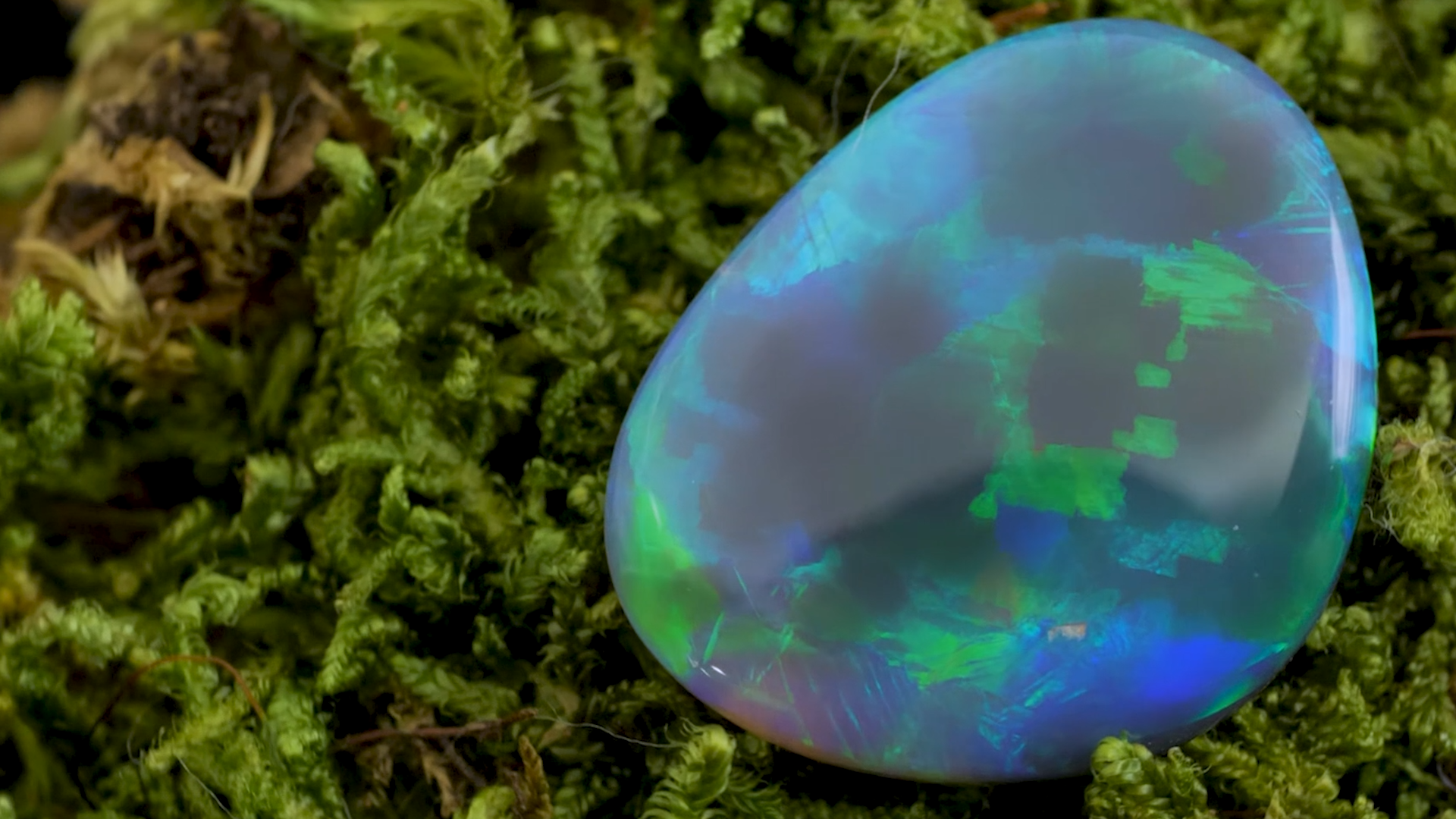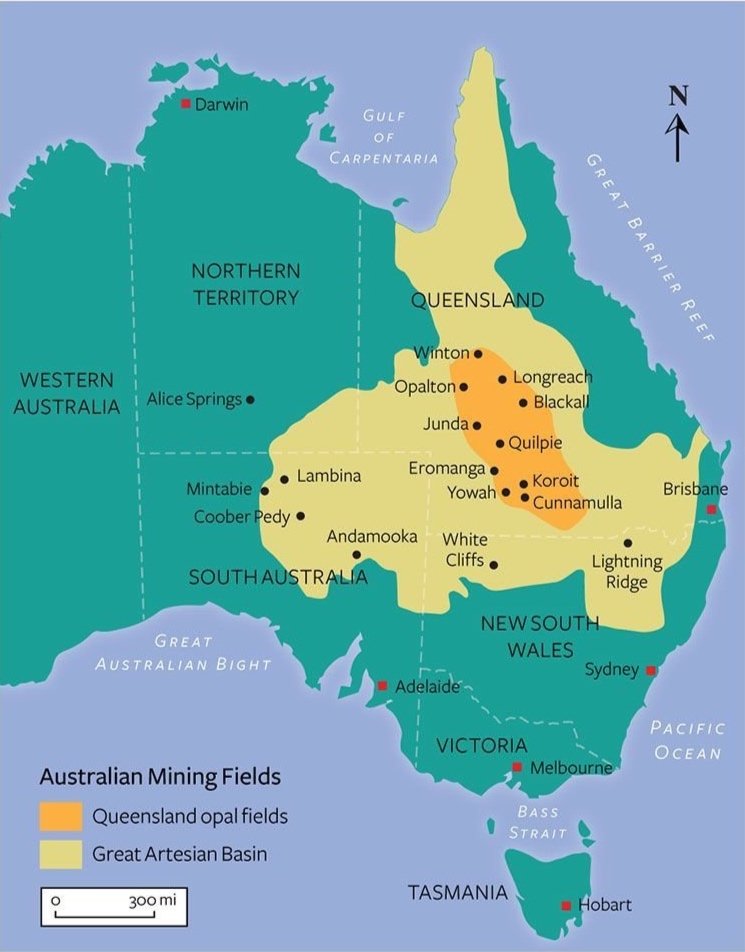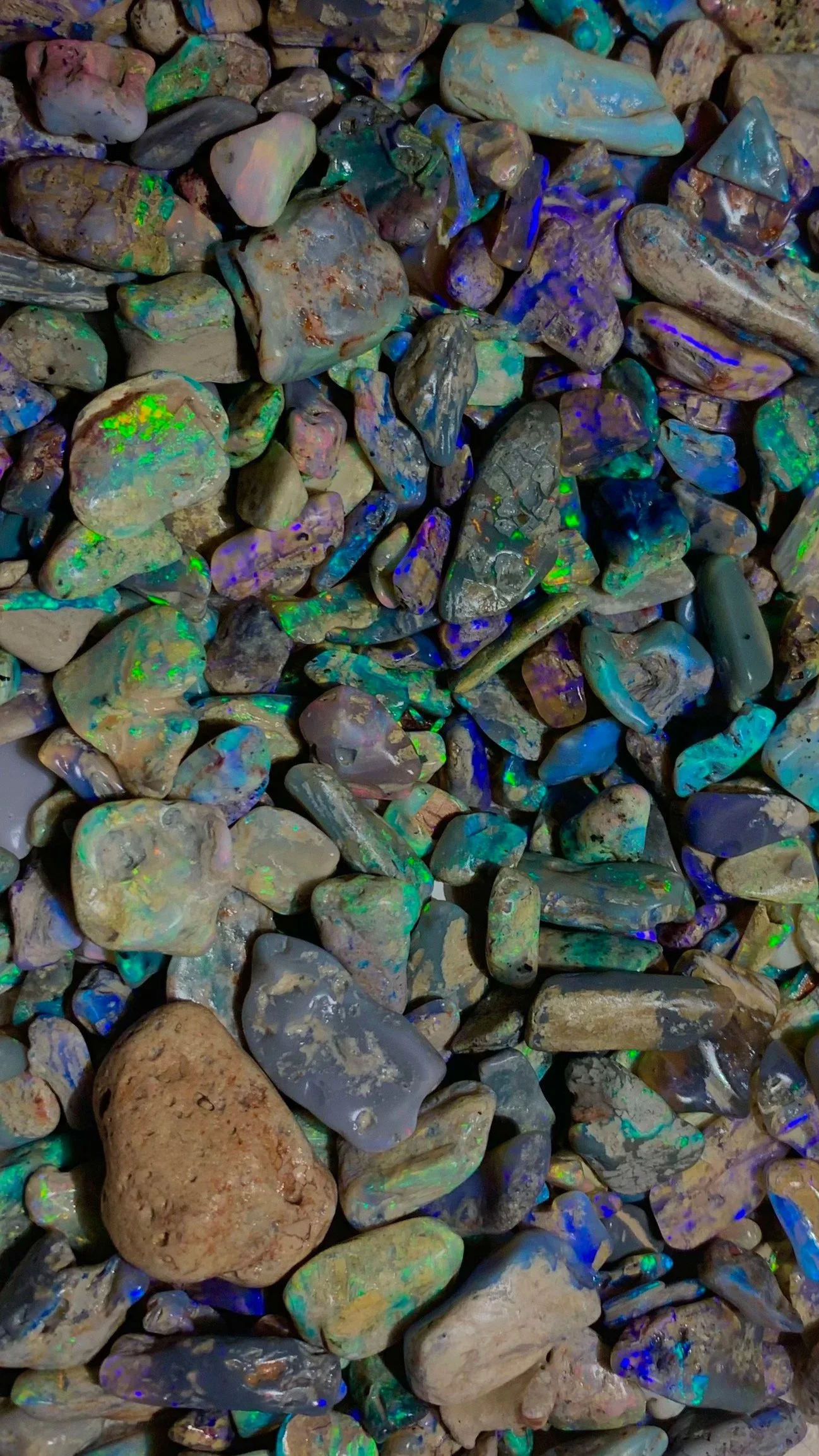
Opal Education
How is opal formed and mined? Why is Australian opal so rare? What gives opal its value?
Formation
Opals are found in a variety of locations throughout the world. While the composition of opal remains very similar globally, the characteristics of each stone vary drastically. We choose to work exclusively with Australian opals from Lightning Ridge Australia.
Many common commercial gemstones need incredible heat and pressure to aggregate and form their crystals. Opals form within sedimentary geologic environments, rather than igneous or metamorphic environments. Opals need a very particular combination of silica-rich deposits, exactly the right kind of semi-porous sediments, water, and time. When these factors align there is a chance that an opal with color can form.
Australian Opal Oasis
Australia's rich opal-bearing sediments began to form over 110 million years ago, during the Cretaceous period. Lightning Ridge Australia, which is now an arid desert environment, was once a thriving inland sea lined by a coniferous coastal environment. As the climate in this area changed over time, the sea began to dry up, leaving behind rich silica deposits. Over thousands of years, groundwater seeped through these deposits and carried the silica down through the porous ground. The silica-rich groundwater eventually pooled in any small gaps or fractures in the ground and congealed and stabilized over millions of years, forming the opal we see today.
Australian
Opalized Fossil
The story of Australia’s ancient ecosystems is preserved in gems. Opalized fossils are formed when opal replaces the remains of plants and animals. Without the demand for opal & the long history of its mining, much of what we know about ancient Lightning Ridge organisms and the environments they lived in would still be buried beneath our feet.
Every once in a while, we find opalized plant and invertebrate remains in our rough opal parcels. We treat these finds as specimens. We prefer not to cut or alter them from their natural state. Once these fossils are carefully prepared they are cataloged into our reference collection, where they can be used as an educational tool in the future. Anything that may be of scientific significance will be donated to an Australian institution for proper research.
Seeing a plant or animal that lived 110 million years ago preserved as one of the rarest and most beautiful gems is an awe-inspiring experience. We believe this experience provides a powerful connection to the incredible history of the natural world and reminds us why this history is so important to preserve and learn from.
Opal Stability
We work almost exclusively with opal from the Lightning Ridge region of Australia.
Lightning Ridge is known for producing the best quality gem opals in the world. This is in part because it is one of the only places on earth where natural Black Opal is formed. The natural dark color of the stone makes the colors incredibly vivid and rich, allowing the colors to pop against the dark background color. Lightning Ridge also has some of the hardest and most durable opal on earth. Opal from Lightning Ridge have a hardness range of 5.5-6.5, and some areas produce stones with a hardness of nearly 7.5, which is similar to quartz. Due to their crystalline arrangement and conchoidal fracture, opals have extra structural integrity when they have a rounded shape with no corners. Having any kind of sharp corner leaves your stone incredibly vulnerable to impact fractures, so opals are almost never faceted.
Opal Color & Pattern
If the silica spheres that make up an opal aren’t arranged in just the right pattern with just the right size, the stone will be colorless. Colorless opal is called potch and has no value in the gemstone market. Australian opal miners will often find hundreds or thousands of pieces of potch before finding even one piece of color. This can mean miners in Lightning Ridge can go an entire season without finding a single gem.
Finding any color at all is the first challenge for miners. Then, they work to unearth specific colors that are the rarest and most valuable. The most elusive and sought-after combination is red color on black gem opal. Opal formation is improbable to begin with, but conditions have to be perfect to produce a red gem. The size of the individual silica crystal spheres inside an opal determine what colors you see within it. Small spheres that are organized enough to produce color will refract shorter wavelengths of light. The most common colors found in Lightning Ridge opal are blue and violet. This is because as the spheres get larger, the wavelengths of light they refract get longer. Only the largest and most perfectly formed spheres can ever produce red, making finding a red gem a small miracle.
Water Content
All opals form from water, and as a result all opals have a certain water content, even in the finished gem. This is especially apparent in Ethiopian Welo Opals. Welo Opal has a much higher content than other opal types. Some Welo stones are made up of as much as 15% water. As a result, the stone will absorb or release water based on the humidity of the environment it is in. This can be problematic because a stone absorbing and releasing water over and over can cause stress on the stone and it can fracture or craze. This is certainly not the case with all Ethiopian Opals, but it can happen. We specialize in Australian opals so if you have questions about Ethiopian opals we recommend you talk to someone who specializes in them.
We prefer to work with Australian Opals because of their lower water content. Lightning Ridge opal is made up of only 2-4% water, so the stone is not constantly taking in and releasing water. As a result, the stone is much more stable, so its appearance will not change and there is little to no chance of the stone ever naturally cracking.
Rarity & Value
Australian Opal is called the Queen of Gems because of its endless variations of vivid colors and patterns. Australian Opal can contain almost any color the human eye can perceive, and can be completely transparent, black as pitch and anywhere in between. So how do we start to go get an idea of the value of such a complex gem? We can start by assessing the stone in these 6 different categories:
Brightness:
The brightness of an opal is assessed on a 1 - 5 scale by the vividness of the opal and how much of the stone it takes up. Some opals can be very bright but only from a specific angle. This is called directionality and affects the overall brightness grade of the stone.
Color:
The colors present in a gem can greatly affect the price of the stone.
The most common colors found in Lightning Ridge Opal are purples and blues. Blue-green pallet gems are a little rarer and more highly sought after for their earthly colors. Cooler colors are generally less expensive than warmer colors. The highest value color is red. Stones with red as a primary color are extremely rare and can reach a price of $35,000/ct. The more colors a stone has, the rarer and more valuable it is.
Shape /Cut :
The shape and cut of an opal can also have a large effect on the stone’s appearance and value. Inclusions, scratches, or divots in the stone’s face can lower the price drastically with many buyers staying away from included stones altogether. Stones that have a higher dome or a thicker lens of color bar are worth a great deal more than stones that are fairly flat on the face with little to no dome. Generally speaking round and oval gems generally fetch a higher demand because of their setting accessibility. Top-quality opal will benefit from an opal cutter perfectly calibrating the dome to match the color bar. This is much more easily accomplished on stones with an oval or round shape, so these are often the designated shapes for top-quality material.
Body tone:
The body tone of an opal is the darkness or background shade of the stone. Body tone is assessed on a 1-10 scale, 1 being pitch black and 10 being white.
Black opal ranges from N1-N4
Semi Black opal ranges from N5-N6
Grey base opal ranges from N7-N8
White opal ranges from N9-N10
Pattern:
Opals from lightning ridge can present their color in all sorts of geometric and abstract strokes of color. Having an attractive or rare pattern in your gem can greatly increase its price and rarity. We are currently working on a full guide to opal patterns that will be added to our website soon.
Weight:
Opals are valued by price per carat, so the carat weight of a finished gem is the price multiplier.












